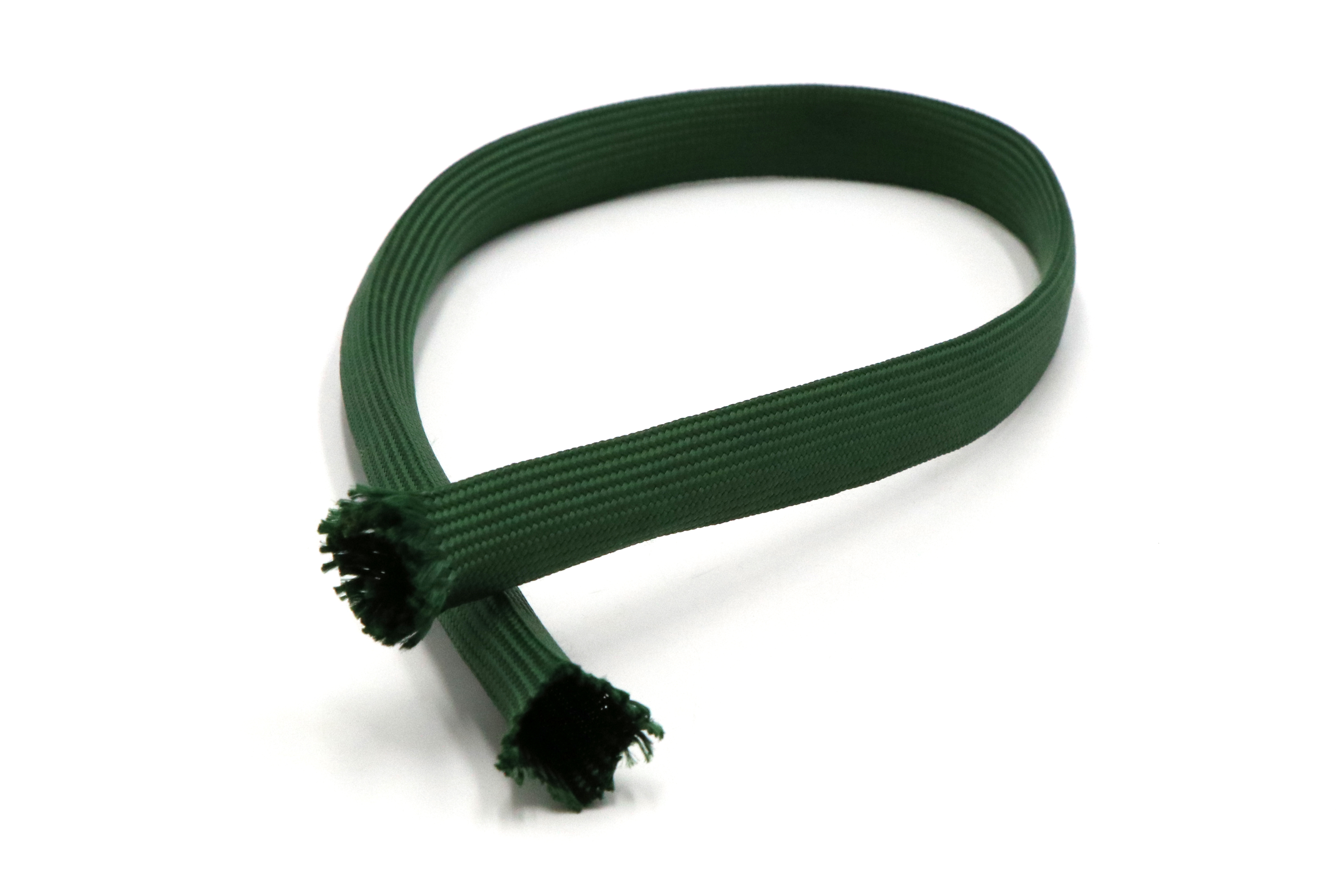Polyimide braided sleeves are used to cover the cable harnesses at the joints of industrial robot mechanical arms.
Oct 09,2025

Polyimide tubing is created by weaving it into a tubular structure using a knitting machine—similar to how a sweater is made. It typically features a flexible, expandable mesh design.
1. Excellent resistance to high and low temperatures
It can withstand long-term continuous use across a temperature range from -269°C to +260°C, and its short-term thermal resistance can even exceed 400°C. Importantly, it neither becomes brittle at low temperatures nor melts under high heat—its glass transition temperature (Tg), typically above 360°C, ensures exceptionally stable performance.
2. Excellent electrical insulation performance
It possesses high dielectric strength (breakdown voltage) and volume resistivity.
The dielectric constant and dielectric loss factor remain stable over a wide range of temperatures and frequencies, maintaining excellent insulation even under harsh conditions such as high temperature and high humidity. This makes it an ideal insulating material for high-end electronics.
3. Flame-retardant and low-smoke, non-toxic
It inherently possesses flame retardancy, eliminating the need to add flame retardants.
When burned in flames, it produces very little smoke and does not release toxic or harmful gases, meeting the stringent safety requirements of industries such as aviation and high-speed rail.
4. Excellent Flexibility and Elasticity
Thanks to its braided structure, it can easily bend and pass through narrow spaces, while also stretching within a certain range to wrap around wire harnesses of varying diameters—making installation incredibly convenient.
5. Excellent Expansion Ratio
It can be made incredibly fluffy, expanding to wrap bundles of wires that are much larger in diameter than the material itself—then tightening securely to provide all-around protection.
6. Excellent heat dissipation
The mesh structure allows air circulation, helping to dissipate heat from the wiring harness and preventing heat buildup.
7. Weight Loss
Under the same length, a woven structure is typically lighter than a solid-wall tube, which is crucial for lightweighting applications in aerospace and automotive industries.
8. Easy to trim and branch out
It can be easily cut with scissors—no special tools required—and conveniently handles situations where wire harnesses branch out.
Polyimide tubing has become an indispensable foundational material in high-end equipment and cutting-edge technologies, thanks to its lightweight design, high reliability, and exceptional adaptability to extreme environments.
1. New Energy Vehicles and Intelligent Connected Cars
Inside the drive motor:
Card-Edge Flat Wire Motor Insulation Sleeve "This is the core application. It is used to wrap each hairpin-shaped flat copper wire, serving as inter-turn insulation. The material must withstand corona erosion under high-frequency pulse voltages, high temperatures (>200°C), and chemical attack from cooling oil. Corona-resistant polyimide tubing is the only option that can ensure long-term reliability."
Motor lead wires & phase pole connection line insulation: Protect the high-voltage connection wires inside the motor to prevent short circuits to the housing.
Battery System:
High-voltage busbar insulation protection: Slipped over the copper or aluminum bars connecting battery modules, providing insulation and mechanical protection to prevent short circuits caused by vibration-induced wear.
Battery module internal sampling harness protection: The wiring harness enveloping the voltage and temperature sensors is designed to withstand high-temperature splashes that may occur during thermal runaway of the battery cells.
High-voltage connector tail jacket: Used at the crimping point between wire harnesses and connectors, providing stress relief and additional insulation.
Electrical Control System (Inverter, DC-DC): Insulation of the power terminals in the internal IGBT module, as well as protection for the internal high-voltage wires.
Vehicle wiring harness:
Charging cable: Exchange the insulation layers of the internal high-voltage wires in both AC slow-charging and DC fast-charging gun cables.
High-Temperature Area Wiring Harness: Protect the braided sleeving of low-voltage signal harnesses near high-temperature areas such as the motor, PTC heater, and brake system, to block thermal radiation.
2. Aerospace and Deep Space Exploration
Aircraft engine:
Core Engine Area: The cables for the ignition system wiring harness, fuel metering valve, lubrication system sensors, and static discharge brushes are directly exposed to high-temperature gas environments exceeding 500°C.
Engine wiring harness assembly: Provides comprehensive protection and a fire-resistant barrier for the sensor and actuator wiring harnesses of the engine's entire FADEC (Full Authority Digital Engine Control) system.
Airframe and Onboard Systems:
Fire-resistant cable: Cabin entertainment systems, lighting circuits, and more must meet stringent FST (Flammability, Smoke, and Toxicity) standards—making polyimide the ideal choice.
Equipment wiring harness bundling: Designed for use inside avionics equipment racks, it protects wire harnesses from vibration and wear while remaining lightweight.
Next to the hot air/hydraulic lines: Protect cables passing through high-temperature areas.
Spacecraft and Satellites:
Satellite-borne equipment: Protect internal cables against the intense vibrations during launch and the extreme temperature cycles in space (-150°C to +150°C).
Deep-space probe: For equipment such as rovers, it must be able to withstand cosmic radiation and extreme temperature fluctuations.
Rocket Engine Wiring Harness: Similar to applications in aircraft engines, but with a more extreme environment.
3. Industry and Automation
Industrial robots:
Mechanical arm joint harness: Continuously bent, potentially exposed to lubricants, and located near the heat source of the servo motor—braided sleeving provides optimal protection.
Welding Torch Cable Protection: Resist welding spatter sparks and high temperatures to prevent the cable jacket from burning.
Semiconductor Manufacturing Equipment:
Wafer Processing Equipment: In equipment such as plasma etch and chemical vapor deposition (CVD), the cable insulation used in components like heaters, RF power supplies, and vacuum feedthroughs must withstand high temperatures, resist plasma bombardment, and maintain ultra-high purity to prevent contamination of the process chamber.
Energy and Electricity:
Ultra-High Voltage Transmission and Transformation: Lead protection for temperature sensors used inside transformers.
Nuclear power: Cable protection for instrumentation inside the containment vessel, requiring radiation resistance and high-temperature tolerance.
Wind power: Harness protection within the generator and in the converter system.
4. Consumer Electronics and Home Appliances
High-end home appliances:
Microwave oven: The insulating sleeve for the magnetron power cable.
Air fryer/Oven: Protection of the wiring harness near the internal heating tube.
Dishwasher: Heat the wiring harness near the pump.
Digital products:
Fast-charging charger: Internal transformers and components are miniaturized and densely packed, generating localized high temperatures that serve to insulate and isolate the components.
Drone: The connection cable protection for the power motor and electronic speed controller (ESC) must be lightweight yet reliable.
PREVIOUS:
Related Posts
Contact Us
E-mail:
gdkaidun@163.com
Phone/WeChat:
86-131-3828-6677
Address:
Room 401, Building 21, No. 1, Keqing Road, Yundonghai Street, Sanshui District, Foshan City, Guangdong Province





